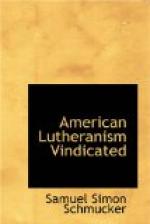Now, every communicant either possesses this faith,
or he does not. If he does, he is justified or
pardoned before he communes; if he is destitute of
this faith, his communing cannot justify or pardon
him; for man is justified by faith alone. Yet
are there thousands of church members who afford no
satisfactory evidence of regeneration, or of that
faith which works by love, and purifies the heart,
and overcomes the world; who, because they approach
the sacramental table with seriousness and sincerity,
and perhaps with some sorrow for their sins, believe
that they obtain pardon for their transgressions,
and yet still continue in their unregenerate state.
It cannot be said that the symbolical books clearly
teach the above error, but they are not sufficiently
guarded, and are understood by many as inculcating
the doctrine, that a sincere and devout participation
of the Lord’s Supper secures the pardon of sin,
even where satisfactory evidences of regeneration
are wanting, the persons referred to mistaking a mere
historical belief for a living faith. Hence, as
the
Scripture nowhere connects the forgiveness
of sins with the duty of sacramental communion,
any more than with the performance of any other prominent
christian duty, it is not proper that we should do
so. The design of the Holy Supper is to show
forth the Lord’s death, to profess the name
of the Redeemer before the world, to confirm the previous
faith of the communicant, to bring him into closest
spiritual communion with his blessed Saviour, and
to secure his special spiritual blessing: but
not to bestow forgiveness of sins upon the unregenerate,
however serious they may be. Against this dangerous
error all should therefore carefully guard, and ever
remember the declaration of the Lord Jesus when he
said, “
Unless a man be born again (become
a new creature in Christ Jesus)
he cannot see the
kindom [sic] of God.”
This superstitious practice, which consists in a prescribed
formula of adjuration, accompanied by various menacing
demonstrations, by the use of which the priest professes
to expel the evil spirits from an individual, of whom
they are supposed to have taken possession, was practised
in the Romish Church, principally before the baptism
of infants. The rite was retained, with an altered
interpretation, in various parts of the Lutheran Church
in Europe, for several centuries. In the American
Lutheran Church, it was never received by the fathers
of our church, and is regarded as unscriptural and
highly objectionable, under the most favorable interpretation
that can be given it.
As exorcism is not touched by the Augsburg Confession,
it is also not discussed by the Rev. Mr. Mann, in
his Plea. But as others have objected to the
Platform for representing it as in any degree a part
of the Symbolic system, we will adduce evidence enough
to satisfy every impartial and reasonable reader,
that it was so regarded for several centuries, by
a considerable portion of the Lutheran Church in Europe;
and that the assertion of the Platform, “that
this rite was retained, with an altered interpretation,
in various parts of the Lutheran Church in Europe,
for several centuries,” (p. 23,) is even
more than sustained.




